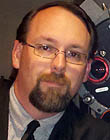|
|
This topic comprises 2 pages: 1 2
|
|
Author
|
Topic: Cue Mark Scribe
|
|
|
|
|
|
|
Leo Enticknap
Film God

Posts: 7474
From: Loma Linda, CA
Registered: Jul 2000
|
 posted 01-14-2013 09:37 AM
posted 01-14-2013 09:37 AM





quote: Jack Theakston
Once you scratch a cue into a print, it's there forever.
However, which is the lesser of two evils - doing it once and doing it properly in a controlled lab environment, or sending the print into circulation without cues and having a bunch of 'projectionists' who don't care about their prints as much as we do defacing 100-200 feet at the end of every reel with their own amateur efforts?
When I was a full-time projectionist on the arthouse circuit in the late '90s I would see this a lot, and especially with French prints. For some reason the two big Paris labs, LTC and Eclair, did not put changeover cues on their prints. By the time I would get them (a long way from London and so near the end of the distribution chain) they would often have 5-10 sets of DIY cues on them - chinagraph slashes, hole punches, attempts to scrape the emulsion away to form a dot, you name it. And the process of applying them caused more scratching and dirt on the last 20-30 seconds or so of action, thereby making the viewing experience even worse.
Agreed completely that in an ideal world, everyone would use click strips or some method of cueing their changeovers that at the very least is reversible and ideally is invisible as well. Hopefully, as the use of film declines and then only places left projecting it are run by professionals who care about what they're doing, the problem will diminish. But even now I'd be very cagey about putting a 35mm print - especially of an arthouse or re-release title, which is more likely to be run with changeovers - into distribution without any visible cues at all on it.
| IP: Logged
|
|
|
|
Jack Theakston
Master Film Handler
Posts: 411
From: New York, USA
Registered: Sep 2007
|
 posted 01-14-2013 11:56 AM
posted 01-14-2013 11:56 AM




Leo: Points all taken, and that is a realistic viewpoint on this subject. I think what worries me more (and this doesn't apply to Christian, but other projectionists) is that with scribes "out there," some projectionists get a little "scribe crazy." Is it better to have a Clint-Phare on a print rather than someone's nail scratch into the emulsion? Of course.
However, a few years ago, a friend of mine who recently restored a classic film he owns the rights to had a screening in New York where a certain venue, against his instructions took it upon themselves to C-P a print that HAD lab cues printed into it, on the pretense that it was during a dark scene and "hard to see." (I also screened the print and did not have any trouble seeing this cue mark.) This really bothered the owner of the print to the point where he (rightfully) asked the venue for compensation for the damage, which after a bit of harassing, they finally paid.
So I guess my point is that I don't mind an archive or a lab having the tool on-site, but that I hope the technicians and projectionists know for sure that what they're doing is OK with the print owner, and that it's applied properly.
| IP: Logged
|
|
|
|
|
|
|
|
Stephen Furley
Film God

Posts: 3059
From: Coulsdon, Croydon, England
Registered: May 2002
|
 posted 01-15-2013 07:52 AM
posted 01-15-2013 07:52 AM




This is something which used to really annoy me in the days when I was projecting. Even when the print had proper cues, in the correct places thee would often be anything up to half a dozen additional sets, in different places.
I even met one projectionist many years ago who used to scribe huge crosses on prints well in advance of the proper ones, probably getting on for a second. He insisted that he had to do this as his machines were low to run up. He absolutely refused to adjust the position where he laced up to compensate, saying that he'd been trained to do it on the '8', and he wasn't going to change. I don't know how he got on with SMPTE leaders.
For some reason, and I don't know why, places which run 2k reels seem to be worse at this than those which run 6k reels; if this has been one anywhere then it's generally on all reels, rather than just on part 4 or 5. No excuse for it at all.
| IP: Logged
|
|
|
|
|
|
|
|
|
|
|
|
|
|
All times are Central (GMT -6:00)
|
This topic comprises 2 pages: 1 2
|
Powered by Infopop Corporation
UBB.classicTM
6.3.1.2
The Film-Tech Forums are designed for various members related to the cinema industry to express their opinions, viewpoints and testimonials on various products, services and events based upon speculation, personal knowledge and factual information through use, therefore all views represented here allow no liability upon the publishers of this web site and the owners of said views assume no liability for any ill will resulting from these postings. The posts made here are for educational as well as entertainment purposes and as such anyone viewing this portion of the website must accept these views as statements of the author of that opinion
and agrees to release the authors from any and all liability.
|

 Home
Home
 Products
Products
 Store
Store
 Forum
Forum
 Warehouse
Warehouse
 Contact Us
Contact Us




 Printer-friendly view of this topic
Printer-friendly view of this topic















